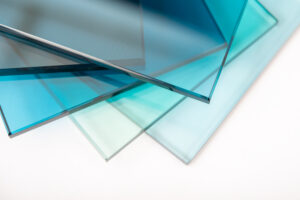Definition and Production Process:
Tempered glass is produced by heating the glass to approximately 650°C–700°C and then rapidly cooling it. This thermal process induces compressive stress on the surface and tensile stress inside the core. As a result, tempered glass becomes 4 to 5 times stronger than standard annealed glass. When broken, it shatters into small, blunt fragments, minimizing the risk of serious injuries.

Technical Specifications:
- Thickness Range: 4 mm – 19 mm
- Minimum Size: 300 x 300 mm
- Maximum Size: 2400 x 4500 mm
- Color Options: Clear, Smoked, Green, Bronze, Blue, Frosted (on request)
- Edge Options: Ground, polished, C-edge (optional)
Applications:
- Façades and curtain walls
- Glass doors and partitions
- Shower enclosures
- Furniture and shelving
- Staircase and balcony railings
- Automotive windows
- Elevator glass panels
Advantages:
- High impact resistance
- Thermal resistance (tolerates temperature differences up to 250°C)
- Breaks into harmless pieces
- Long-lasting and safe
Important Notes:
- Cutting, drilling, or edge processing is not possible after tempering.
- The glass must be fully shaped and processed before tempering.
